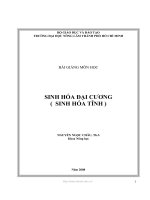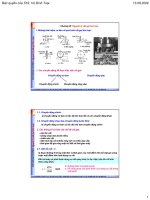Project môn học cơ khí đại cương
Bạn đang xem bản rút gọn của tài liệu. Xem và tải ngay bản đầy đủ của tài liệu tại đây (544.26 KB, 9 trang )
3/1/2022
Mini Project
Introduction to manufacturing
engineering
Name: Nguyễn Trọng Đạt
Student ID: 20195766
Course code: ME2036
Class code: 128364
No: 15
Product: Mold
NGUYEN TRONG DAT 20195766
HANOI UNIVERSITY OF SCIENCE AND TECHNOLOGY
Mini project
Introduction of manufacturing engineering
Part I: Introduce the product.
1.1 Basic characteristics and applications.
-Molding is the process of manufacturing by shaping liquid or
pliable raw material using a rigid frame called a mold or matrix. This
itself may have been made using a pattern or model of the final object.
-Permanent mold casting is a metal casting process that employs
reusable molds ("permanent molds"), usually made from metal. The
most common process uses gravity to fill the mold, however gas
pressure or a vacuum are also used. In such molds, the two mold halves
are mounted and aligned on a pin. There is no mechanical connection
between the mold parts, and they can be completely separated from
each other after casting. When the mold halves are closed, the space
between the closed mold parts is the shape of the casting. Liquid metal
is transferred to the mold cavity through tapping spout and riser. The
mold cavity should be designed appropriately so that the air inside the
mold can escape during casting.
+ Two halves of mold are made from material with high
resistance to erosion and thermal fatigue: Iron, steel, bronze, graphite,
or refractory metal alloys.
+ Precise products made by pouring low melting alloys (Al, Mg,
Zn) into CNC machined steel (or grey iron) molds under gravity,
centrifugal force, or low pressure
-Based on the design characteristics indicated above, there are
different types of molds available.
Die Casting
Permanent Metal mold
- Metal Molds can be applied in: Transport: Automobile,
aerospace, railways, and shipping; Heavy Equipment:
Construction, farming, and mining; …...
1.2 Dimension and features of metal mold.
-In this project, I will introduce the features, specifications,
manufacture, and applications of Permanent metal mold.
- As the name implies, Metal mold casting is pouring liquid metal into a
metal fabrication mold with two halves of mold.
- Because the metal mold has different physical and mechanical
properties than the sand mold material, it has the following
characteristics:
+ Advantages: It produces castings with a good surface finish, close
dimensional tolerances, uniform and good mechanical properties, and
high production rates, Labor costs are kept low by automating the
process, Rapid heat transfer to the mold results in finer grain
structures, better strength properties than casts made by sand casting
method, less subject to shrinkage and gas porosity than sand castings,
no entrapped gas.
+Disadvantages: Metal molds have no settlement properties and are
not capable of venting gases, this will cause casting defects. Mold
manufacturing costs are high. This method is only suitable for mass
production with simple, small, or medium castings. Equipment costs
can be high because of high die costs.
Part II: Choose the material
-Because the permanent molds that are exposed to very high
temperatures and changes in temperature. Permanent molds can be
made up by cast iron, steel such as H10, H11, H12, H13, H21,
X38CrMoV5-3, ……… I choose AISI H13(medium carbon steel, hot work
mold steel).
- AISI H13 steel is the most popular and most versatile, hot work
mold steel, providing a good balance of toughness, heat check
resistance, and high temperature strength, in addition to moderate
wear resistance. H13 steel can resist softening to 550°C and has good
resistance to heat checking.
• Chemical properties:
Element
AISI H13
C
Si
Mn
P
S
Cr
Mo
V
0.32-0.45
0.90-1.25
0.20-0.60
0.030max
0.030max
4.75-5.50
1.10-1.75
0.80-1.25
• Physical properties:
Density (20 °C)
7.80 g/cm3
Melting point
1427°C
Specific Gravity
7.75
Modulus of elasticity (kg/m3)
8138
• Mechanical properties:
Tensile strength, ultimate (20 °C)
1200-1590 MPa
Tensile strength, yield (20 °C)
1000-1380 MPa
Reduction of area (20 °C)
50.00%
Modulus of elasticity (20 °C)
215 GPa
Poisson’s ratio (20 °C)
0.27-0.30
Elongation at break (HRC)
35-45
• AISI H13 applications:
AISI H13 steel is an air hardening, 5% chromium die steel, which is
an excellent choice for a wide range of hot work and cold work
applications. Typical applications include die casting dies for
aluminum, magnesium and zinc, extrusion dies for aluminum and
brass, liners, mandrels, pressure pads, followers, bolsters, die cases,
die holders and adaptor rings for copper and brass extrusion. H13
steel is used to produce hot stamping and press forge dies, split hot
heading dies, gripper dies, hot punching, piercing, and trimming
tools. Other applications include plastic molds, shear blades for hot
work and hot swaging dies.
Part III: Manufacturing Process
To make this mold, I will go through
• Process 1: Cutting work piece
-Choosing an AISI H13 tool steel bar with
350mm length, 210mm width, and cut a
work piece for 45mm height.
• Process 2: Surface milling
-Because the bar seems to be not smooth,
using face milling to achieve the required
smoothness and reach the desired size. Because the length of the
H13 steel bar is 350mm length, 210mm width, and 45mm height,
then we mill all surfaces to reach the
desired length, width, and height are
330mm, 200mm, and 40mm, respectively.
• Process 3: Shaping the product
-In this process, using end milling to make
a shape for a desired product which can
be casted from the mold.
• Process 4: Making hold
-Make holds for 2 molds fit together.
Using drilling to make 4 holds that can
combine 2 molds.
• Process 5: Making the other half
of mold.
-Repeat all the processes above to
make the other half with reversely
detail. Then we obtain 2 havles
with all detail fit together.
• Process 6: Check the product
-Check 2 halves mold if there are
match and have no failure detail
Part IV: Heat treatment
- Hot-working AISI H13 tool steel offers high hardenability, excellent
wear resistance and hot toughness. To obtain excellent mechanical
properties, we use quenching and tempering.
-Heat treatment process:
+ The hardness of 54~55 HRC can be obtained by quenching at 1 030 ℃,
and the grains begin to grow beyond 1 040 ℃. Therefore, the heat
treatment temperature range of 1 030~1 040 ℃ is recommended. At
the same time, special attention should be paid to pre-cooling to 20~30
℃ (950~980 ℃) above Ac3 when coming out of the oven to reduce
stress concentration and avoid cracking. Heating temperature 1020 ~
1050℃, oil cold or air cold, hardness 54 ~ 58HRC; It is required that the
quenching process specification of the die mainly hot and hard, the
heating temperature is 1050 ~ 1080℃, the oil is cold, and the hardness
is 56 ~ 58HRC.
+ In order to eliminate the stress and improve the high temp toughness
of H13 forgings must be tempered at high temperatures, secondary
tempering can be used to improve the life of the die due to the good
fire resistance and secondary hardening of the alloy elements in the
steel. The tempering temperature (580±20 ℃) was used to obtain the
hardness of 47~52 HRC. The microstructure after tempering is
tempered martensite and a small amount of granular carbides.
+ Tempering should be done twice. When tempering at 500℃, the
secondary hardening peak appears, with the highest tempering
hardness and peak value around 55HRC, but the worst toughness.
Therefore, according to the use of the mold needs 540 ~ 620℃
tempering is better. Quenching heating shall be preheated twice (600 ~
650℃, 800 ~ 850℃) to reduce the thermal stress generated during
heating.
Part V: Conclusion
5.1 Results
-The Permanent Mold Casting Process
consists of pouring molten metal into a
permanent mold, usually created from
iron or steel. The metal flows into the
mold cavity under gravity pressure;
flowing into the small crevices of the
mold to produce intricate and fully
formed castings.
- Permanent mold casting is used heavily in the automotive industry to
create parts like gears, castings, suspensions, fuel injection housings,
and engine pistons. Aircraft parts are also often made via permanent
mold casting.
5.2 Comment
-Permanent mold casting can be used for high production rates, and
you can reuse molds many times. Low labor costs using highly
automated processes. The finish pieces have a good surface finish and
good dimensional accuracy. Permanent mold casting also produces
little waste.
-Although permanent mold casting has a lot of advantages, it also has
drawbacks. Because of the high tooling cost involved, a high production
volume is needed in order to make this process and economically viable
manufacturing option. A high tooling cost and long setup time. Only
non-ferrous metals may be cast by this process.









